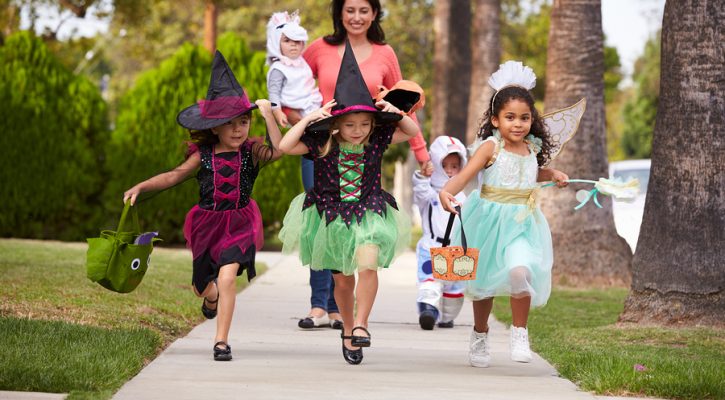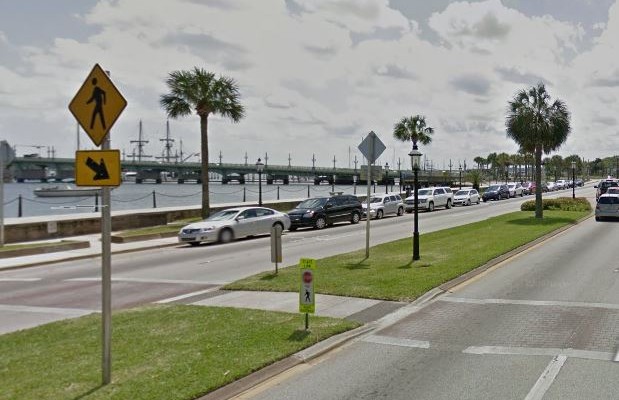Tag Archive: pedestrians

Holiday Driving: Halloween Safety Tips
October 28, 2016
The chill is in the air, orange is the dominant color and kids are beginning to think of their plans for Halloween. Before you go out shopping for costumes and buying bags of candy this year, consider a few safety tips and spend a few minutes planning for the night ahead.
- Identify what type of celebrations will be taking place and where they will be located. Not only will it help determine your plans, it will help you be an aware driver as you travel on the roadways. If you’re attending a party, plan for a designated driver or commit to not drinking. Even small amounts of alcohol can impair your judgment and driving. Driving under the influence can kill or cause trauma, be expensive and embarrassing.
- When costume planning, make sure that all costumes fit appropriately and won’t restrict movement or visibility, either as a pedestrian or behind the wheel. Ensure foot wear is sturdy. Tripping, falling, difficulty steering or braking can be dangerous!
- Add reflective tape to costumes and replace flash light batteries to ensure you will be visible, whether escorting trick or treaters or attending an event yourself. Make sure that any children you’re with have flashlights, glow stick, bright candy bags, and reflective tape on costumes as well. Clear up any yard obstructions, water hoses, and overgrown vegetation to make it easier to see and maneuver for both pedestrians and vehicles.
- Know your planned route, to avoid the unexpected. Plan to travel in well lighted areas. If walking, use sidewalks and crosswalks. If driving, avoid areas of heavy pedestrian traffic and park in areas with the greatest visibility. Select alternate routes that will provide the least amount of risk and the most amount of safety. Arrange to give yourself extra time to and from your destination.
- Know what night of the week Halloween falls on. If Halloween is on a weekend, expect the festivities to begin early in the day and prepare to be a defensive driver. If it is on a weeknight, children will be starting their rounds before the evening rush hour is over. Be especially watchful and, if you can, avoid driving on Halloween altogether.
- Be alert for kids playing in costumes during the day, darting from house to house or in between parked cars. Pay special attention beginning at 4:30pm for the younger treat seekers. Turn on your head lights to make your vehicle more visible. Dusk is the most dangerous time of day because lights and shadows can fool you so drivers need to be especially vigilant.
- Reduce distractions. Make sure your cell phone is on silent, your radio volume is low and your passengers are aware to minimize distractions and assist with being alert to the surrounding environment.
- Be extra cautious as you pull into and leave driveways, parking lots and alleys. Watch for children who may dart out between cars, at roadways, medians and on curves. Be sure to check your blind spots thoroughly and maintain a search and scan of the driving environment every few seconds.
- Travel well below the posted speed limit. Be extra patient with pedestrians and other vehicles and always be prepared to stop at a given moment. Other drivers may be distracted by the trick or treaters inside their vehicle and may not see you. Avoid passing or going around stopped vehicles. They may have passengers entering and exiting hurriedly and carelessly.
Halloween can truly be a fun night full of great memories! Take a few steps to keep it safe and trouble free.

Ask The Traffic School Instructor: Do Pedestrians Always Have The Right-Of-Way?
January 13, 2016
Question: I was attending a work related safety training session and the instructor said that, in Florida, pedestrians don’t have the right of way. Is that true?
Answer: For the most part, no, it isn’t true but it depends on the circumstances.
First off, we have to look at the term “right-of-way.” There’s a lot of confusion about that term and people tend to think in terms of who has the right-of-way in a given situation when, in fact, no one has the right-of-way. The law doesn’t give anyone the right-of-way; it only says who should give up or yield the right-of-way to another. You can’t take the right-of-way, you can only give it to someone else and the law lists the circumstances in which a driver should give up the right-of-way to another.
Let’s look first at what the law requires of pedestrians:
- On roadways where there’s a sidewalk, pedestrians must stay off the paved portion of the roadway reserved for vehicles.
- If there’s no sidewalk, pedestrians are required to walk on the shoulder on the left side of the road facing oncoming traffic.
- Pedestrians are only allowed to cross the roadway at a marked crosswalk or at an unmarked crosswalk at an intersection. (Even if it’s not marked, the area next to an intersection is considered to be a crosswalk.)
- Pedestrians are required to obey all traffic signals and signs just like drivers.
- Even if they’re crossing at a marked or unmarked crosswalk, pedestrians are required to give up the right-of-way if a vehicle is approaching so closely that it wouldn’t be possible for it to safely stop in time.
Now let’s look at those times when drivers are required to give up the right-of-way to pedestrians:
- Drivers are required to yield the right-of-way by slowing or stopping, if necessary, when a pedestrian is crossing the street in a marked or unmarked crosswalk.
- If a pedestrian is crossing the street at a crosswalk and is on the driver’s side of the road or will be on the driver’s side of the road by the time the driver gets there, the driver is required to slow and stop, if necessary, for the pedestrian to pass.
- On a multi-lane roadway, if a driver ahead has stopped for a pedestrian in the crosswalk, drivers approaching in the other lanes must also stop until the pedestrian has safely crossed.
- When a driver is entering the roadway from a parking lot, driveway, or alley, the driver must yield to pedestrians on the sidewalk before proceeding.
- When turning a corner, drivers must yield to pedestrians who are already in the crosswalk.
Special circumstances:
If a blind or visually impaired pedestrian, using a white cane or guided by a guide dog, is attempting to cross the street, whether at a crosswalk or not, all traffic in both directions must come to a complete stop.
Watch for children:
Watch out for children, especially near schools, parks, and residential zones. Kids are in their own little world and they don’t care what the law says.
Vulnerable road users
A new law went into effect in Florida a couple of years ago that lists those who are regarded as vulnerable road users. Vulnerable road users include:
- Pedestrians, including those working on the roadway
- Users of bicycles, mopeds, or scooters
- Skaters and skateboarders
- Horse drawn carriages
- Motorcyclists
- Someone riding an animal
- Users of electric mobility assistance devices
- Users of wheelchairs
- Tractors or other vehicles designed for farm use
The new law requires motorists who are involved in a crash with a vulnerable road user to stop and render aid. Those who fail to do so will face severe penalties.
The lists above don’t include every instance covered under the law, just the basic ones. To see what Florida law says about pedestrians, read: The 2015 Florida Statutes – 316.130 Pedestrians; traffic regulations.—
Chimps Do It, Why Can’t We?
April 21, 2015
An interesting study of wild chimps in Uganda’s Kibale National Park shows that chimps are extremely cautious when crossing busy roads. The 29 month study observed the chimps’ behavior when crossing busy highways and little traveled roads.
When crossing roads that were rarely traveled, the chimps used little care and crossed in large groups. However, when crossing a busy roadway with cars traveling 45 to 60 mph, the chimps used great care, they looked both ways and, once they were sure the roadway was clear, they crossed quickly in small groups. Fifty-seven percent of the chimps ran across the roadway. As shown in the video above, the older, stronger chimps would wait and make sure younger or weaker chimps crossed safely.
The researchers hope to use the data they gathered to improve roadway safety for the chimps in the park. Road building is on the rise in Africa and African wildlife will be subjected to more and more roadway hazards.
It would almost seem that the same data from the chimp study could be applied to humans but the chimps seem to show much greater care when crossing a highway than humans do. For one thing, chimps will never be seen talking on a cell phone the way sixty percent of pedestrians in the US do when they are crossing roads; nor will you find them with earbuds in their ears listening to an iPod. The chimps will never make eye contact with a driver and expect him to stop in time.
Distracted walking figures are hard to come by but safety experts feel that emergency room figures don’t tell the whole story when it comes to distracted pedestrian injuries. The Consumer Product Safety Commission says that, if distracted walking figures are similar to distracted driving figures, there may have been approximately two million pedestrian injuries related to cell phone use in 2010.
Not all of those two million injuries involved pedestrians on roadways but the roadway problem is severe. In 2013, there were 4,735 pedestrians killed and an estimated 66,000 injured in traffic crashes in the United States. Pedestrian deaths have made up fourteen percent of the total number of highway deaths for each of the past three years.
Between distracted drivers and distracted pedestrians, it seems that the people who gather and total up crash data are the only ones paying attention to what happens on the road. Everyone needs to start paying more attention to the road; the way chimps do.
